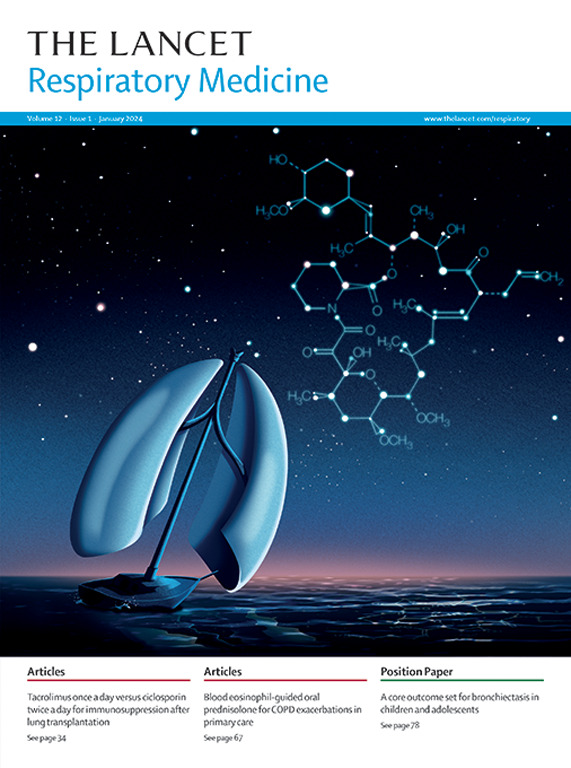Taladegib for the treatment of idiopathic pulmonary fibrosis (ENV-IPF-101): a multicentre, randomised, double-blind, placebo-controlled, phase 2a trial
IF 32.8
1区 医学
Q1 CRITICAL CARE MEDICINE
引用次数: 0
Abstract
Background
The hedgehog (Hh) signalling pathway promotes fibrosis in idiopathic pulmonary fibrosis (IPF), an interstitial lung disease with a high mortality rate. Currently, there is no cure for IPF, and available anti-fibrotics only slow the rate of decline in lung function in IPF. We aimed to assess the safety and efficacy of taladegib (ENV-101), an Hh pathway inhibitor, in IPF in a phase 2a, proof-of-concept clinical trial.Methods
ENV-IPF-101 was a randomised, double-blind, placebo-controlled, phase 2a trial conducted at 16 clinical sites in Australia, Canada, Malaysia, Mexico, and South Korea for patients with IPF older than 40 years who were not treated with concurrent IPF therapy. Patients were randomly assigned to taladegib 200 mg or placebo equivalent once daily, orally for 12 weeks, with a 6-week follow-up. The primary outcomes were safety in the intention-to-treat population and change from baseline in forced vital capacity (FVC) in the efficacy-evaluable population. Exploratory outcomes were measures of fibrosis on high-resolution CT (HRCT) in the efficacy-evaluable population. This study is registered with ClinicalTrials.gov, NCT04968574.Findings
Between Aug 12, 2021, and July 28, 2023, 41 patients were randomly assigned to the taladegib group (n=21; three [14%] female and 18 [86%] male) or the placebo group (n=20; four [20%] female and 16 [80%] male). All treatment-emergent adverse events possibly or probably related to the study drug were grade 1 or 2, all except one were mild or moderate in severity, and none were serious adverse events. The most common treatment-emergent adverse events in the taladegib group were dysgeusia (12 [57%] of 21), muscle spasms (12 [57%] of 21), and alopecia (11 [52%] of 21); none of these events were reported in the placebo group, for which the most common adverse events reported were diarrhoea (four [20%] of 20), headache (three [15%] of 20), and dizziness (one [5%] of 20). Patients treated with taladegib had an improvement from baseline in FVC and across multiple HRCT-based measures of disease. Between-group differences in change from baseline to week 12 favoured taladegib for the efficacy measures of percent predicted FVC (3·95% [95% CI 0·31–7·60]; p=0·035; mean change from baseline of 1·9% in the taladegib group vs –1·3% for placebo), total lung capacity by HRCT (257·0 mL [95% CI 86·8–427·2]; p=0·0040; mean change from baseline of 206·67 mL in the taladegib group vs –55·58 mL in the placebo group), and percent quantitative interstitial lung disease (p=0·047; mean change from baseline of –9·4% in the taladegib group vs 1·1% in the placebo group). No deaths occurred during the trial.Interpretation
The acceptable safety profile and efficacy analyses of taladegib support further investigation in a phase 2b trial in patients with IPF (WHISTLE-PF).Funding
Endeavor BioMedicines.Taladegib用于治疗特发性肺纤维化(ENV-IPF-101):一项多中心、随机、双盲、安慰剂对照的2a期试验
hedgehog (Hh)信号通路促进特发性肺纤维化(IPF)的纤维化,IPF是一种高死亡率的间质性肺疾病。目前,还没有治愈IPF的方法,可用的抗纤维化药物只能减缓IPF患者肺功能下降的速度。我们的目的是在一项2a期概念验证临床试验中评估塔拉德吉(ENV-101)(一种Hh通路抑制剂)在IPF中的安全性和有效性。senv -IPF-101是一项随机、双盲、安慰剂对照的2a期临床试验,在澳大利亚、加拿大、马来西亚、墨西哥和韩国的16个临床点进行,针对年龄大于40岁且未同时接受IPF治疗的IPF患者。患者被随机分配到taladegib 200mg或安慰剂当量,每天一次,口服12周,随访6周。主要结果是意向治疗人群的安全性和可疗效评估人群中用力肺活量(FVC)与基线的变化。探索性结果是在可评估疗效的人群中通过高分辨率CT (HRCT)测量纤维化。本研究已在ClinicalTrials.gov注册,编号NCT04968574。在2021年8月12日至2023年7月28日期间,41名患者被随机分配到塔拉德吉组(n=21, 3名[14%]女性,18名[86%]男性)或安慰剂组(n=20, 4名[20%]女性,16名[80%]男性)。所有可能或可能与研究药物相关的治疗中出现的不良事件均为1级或2级,除一例外均为轻度或中度严重事件,没有一例为严重不良事件。taladegib组最常见的治疗不良事件是发音困难(21例中12例[57%])、肌肉痉挛(21例中12例[57%])和脱发(21例中11例[52%]);在安慰剂组中没有这些事件的报告,最常见的不良事件是腹泻(20例中有4例[20%])、头痛(20例中有3例[15%])和头晕(20例中有1例[5%])。接受塔拉德吉治疗的患者FVC和基于hrct的多种疾病测量均较基线有所改善。从基线到第12周的组间差异有利于塔拉德吉的疗效测量:预测FVC的百分比(3.95% [95% CI 0.31 - 7.60]; p= 0.035;塔拉德吉组较基线的平均变化为1.9%,安慰剂组为- 1.3%)、HRCT总肺活量(257·0 mL [95% CI 86·8-427·2];p= 0.0040;塔拉德吉组较基线的平均变化为206·67 mL,安慰剂组为-55·58 mL)和定量间质性肺疾病的百分比(p= 0.047;与基线相比,塔拉德吉组的平均变化为- 9.4%,安慰剂组为1.1%)。试验期间无死亡病例。塔拉德吉可接受的安全性和有效性分析支持在IPF患者(WHISTLE-PF)的2b期试验中进一步研究。FundingEndeavor共同参与。
本文章由计算机程序翻译,如有差异,请以英文原文为准。
求助全文
约1分钟内获得全文
求助全文
来源期刊

Lancet Respiratory Medicine
RESPIRATORY SYSTEM-RESPIRATORY SYSTEM
CiteScore
87.10
自引率
0.70%
发文量
572
期刊介绍:
The Lancet Respiratory Medicine is a renowned journal specializing in respiratory medicine and critical care. Our publication features original research that aims to advocate for change or shed light on clinical practices in the field. Additionally, we provide informative reviews on various topics related to respiratory medicine and critical care, ensuring a comprehensive coverage of the subject.
The journal covers a wide range of topics including but not limited to asthma, acute respiratory distress syndrome (ARDS), chronic obstructive pulmonary disease (COPD), tobacco control, intensive care medicine, lung cancer, cystic fibrosis, pneumonia, sarcoidosis, sepsis, mesothelioma, sleep medicine, thoracic and reconstructive surgery, tuberculosis, palliative medicine, influenza, pulmonary hypertension, pulmonary vascular disease, and respiratory infections. By encompassing such a broad spectrum of subjects, we strive to address the diverse needs and interests of our readership.
 求助内容:
求助内容: 应助结果提醒方式:
应助结果提醒方式:


